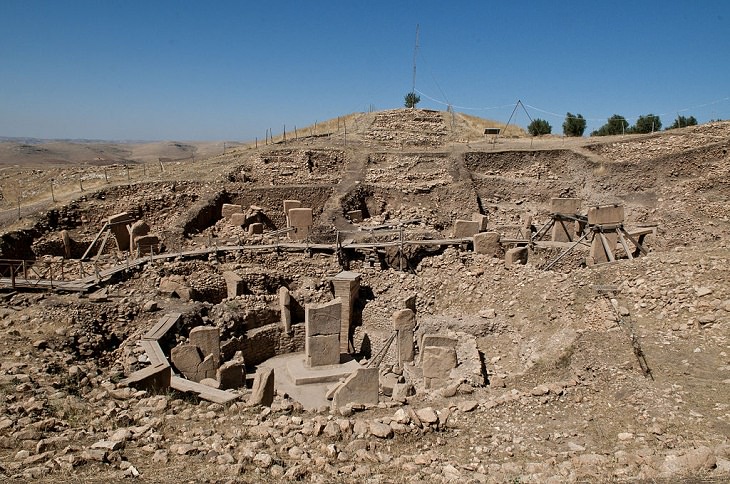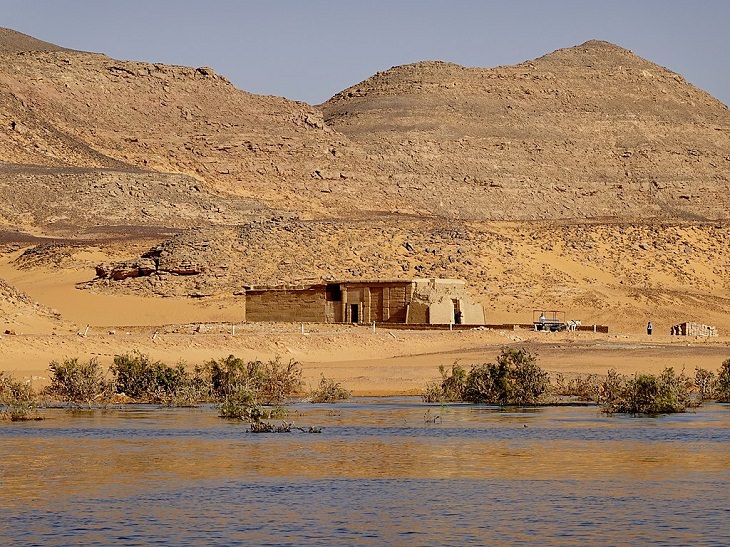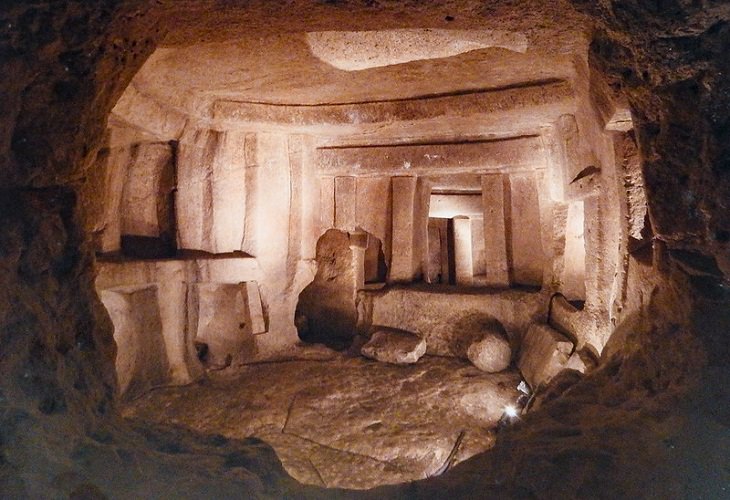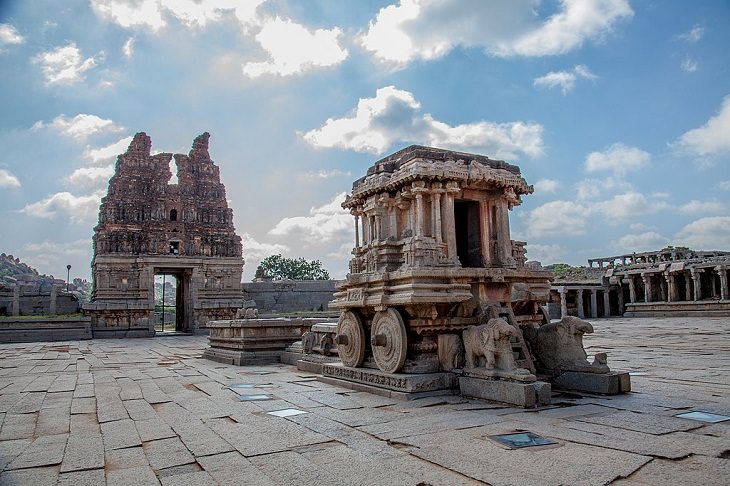Göbekli Tepe is often referred to as the first temple or the oldest temple in the world. Built in 10th millennia BC, this massive, ancient temple in Turkey is made out of pillars structured into great stone rings. This remarkable stone temple was built by prehistoric people (hunter-gatherers) on a hilltop and is considered the oldest human-made place of worship ever discovered. Göbekli Tepe is older than written language and was built even before the beginning of agriculture and animal farming.
Interestingly, the site was initially dismissed by anthropologists who believed it to be a medieval grave. However, Klaus Schmidt of the German Archaeological Institute visited the site in 1994 and felt that there was something massive hidden underneath. This proved true as radiocarbon dating confirmed that Göbekli Tepe was built 11,500 years ago and is truly one of the most monumental archaeological discoveries in recent history.
2. Temple of Amada, Egypt
The Temple of Amada is one of the oldest temples in Egypt and was first constructed by Egyptian pharaoh Thutmose III of the 18th dynasty, sometime around the 15th century BC. Dedicated to the gods Amun and Ra-Horakhty, the temple is considered to be one of the earliest examples of Egyptian temple architecture in the area of the Middle Nile. While it was originally constructed on the east bank of the Nile, the Temple of Amada was moved in the 1960s and '70s to a higher site on Lake Nasser to protect it from flooding.
One of the most significant features of the temple is a relief along with two important inscriptions describing the military feats of the pharaohs who built it - Tuthmosis III and his son Amenhotep II. While the temple is quite small and dilapidated, it is still quite fascinating and vibrant from inside.
3. Luxor Temple, Egypt
Located on the east bank of the Nile River in Luxor, in the ancient city of Thebes, the Luxor Temple was built in 1,100 and 1,600 BC during the reigns of several pharaohs - Amenhotep III (1390-52 BC), Tutankhamun (1336-27 BC), and Horemheb (1323-1295 BC), and then added to by Rameses II (1279-13 BC). The temple was dedicated to the three Egyptian gods Amun, Mut, and Chons, and is considered the largest and most important site in ancient Egypt.
The Luxor temple served as a place of worship for nearly 3,500 years and was also the center of the festival of Opet (ancient Egyptian festival of the second month of the lunar calendar). According to Egyptian legends, the Luxor Temple was “the place of the First Occasion,” where the god Amun experienced a rebirth. Today, the massive Great Colonnade Hall is one of the most vital remains of this vast temple complex.
4. Hypogeum of Ħal-Saflieni, Malta
Built around 2,500 BC, the Hypogeum in Malta is the oldest prehistoric underground temple in the world. The island of Malta has several Megalithic Temples and this structure is easily one of the most remarkable ones. A UNESCO World Heritage Site, the Hypogeum is one of the world’s best-preserved prehistoric sites and contains halls, chambers and passages carved out of rock.
Archeologists believe that the Hypogeum was used as a temple as well as a sanctuary and a necropolis in prehistoric times. The complex is divided into three levels - the upper level (3600-3300 BC), the middle level (3300-3000 BC), and the lower level (3150 -2500 BC). Amazingly, the lower level has a room that is 10.6 meters (35 ft) underground. The structure was rediscovered in 1902 and was restored over mid-2016 to early 2017. It was declared a UNESCO World Heritage Site in 1980.
5. Temple of Apollo, Greece
The Temple of Apollo is located at Delphi, the center of the Ancient Greek world, and was built on the location of two earlier temples. The temple was first built around the 7th century BC by the two iconic architects Trophonios and Agamedes and was rebuilt after a fire in the 6th century BC. The temple was of the Doric order and had 6 columns at the front, and 15 columns at the flanks.
In 373 BC, the Temple of Apollo was destroyed by an earthquake and was rebuilt for the third time in 330 BC. Even after so many centuries, the foundations of the iconic temple still survive today along with several Doric columns that are made of porous stone and limestone. Not much is known about the temple’s interior arrangement. However, ancient writers have mentioned that the walls of the temple were inscribed with the aphorisms of the seven sages.
6. Tchogha Zanbil, Iran
Tchogha Zanbil or Choga Zambil is a ruined palace and temple complex of the ancient Elamite city of Dur Untashi in Iran. Built in 1250 BC, the temple was founded by the Elamite king Untash-Napirisha (1275-1240 BC). The primary feature of the complex is a gigantic ziggurat (a rectangular stepped tower built to honor the main god of the city) dedicated to the Elamite divinities Inshushinak and Napirisha. Outside of Mesopotamia, the ziggurat at Tchogha Zanbil remains the best-preserved monument of this type.
Incidentally, the city was never completed and was attacked and damaged by the Assyrian king Ashurbanipal around 640 BC. The temple complex was excavated between 1946 to 1962 by archaeologist Roman Ghirshman after prospectors for an oil company discovered it in 1935.
7. Vittala Temple, India
The Vittala Temple or Vitthala Temple in Hampi, India, is located near the banks of the Tungabhadra River in Karnataka. Among the many ancient temples at Hampi, the Vittala temple is the most well-renowned because of its stunning architecture and unmatched craftsmanship.
Built in the 15th century by King Devaraya II (1422- 1446 AD) of the Vijayanagara Empire, the temple is dedicated to Lord Vittala or Krishna and is known for its iconic stone chariot and the unique musical pillars. Many sections of the temple were expanded and renovated during the reign of Krishnadevaraya (1509- 1529 AD). The temple is amazingly well-preserved and represents the epitome of ancient Indian architecture.
Liked this post? Please share it with others...







